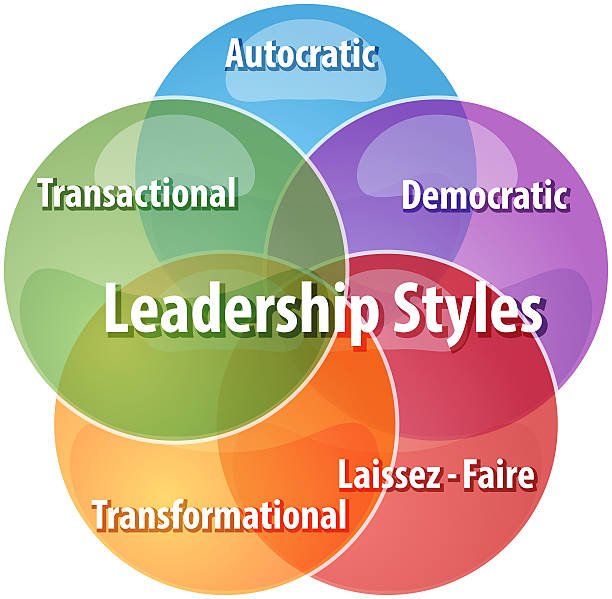Leadership is the backbone of any successful organization. It sets the direction, motivates employees, and fosters a specific work environment. But leadership isn’t a one-size-fits-all approach. Different leaders have distinct styles, impacting the overall culture of the organization. This guide explores five common leadership styles and organizational culture impact.
Companies with cultures that attract top talent see a significant revenue boost – 33% higher to be exact. And a big part of that success? Hiring talented managers translates to a 27% increase in revenue per employee.
A leader’s style has a profound impact on the organization’s culture. The chosen style influences communication styles, decision-making processes, risk tolerance, and employee motivation. Understanding different leadership styles, company culture and values empowers leaders to choose an approach that aligns with their organization’s goals and fosters a good corporate culture.
The Five Key Leadership Styles

1- Autocratic Leadership
Leadership styles are like fingerprints – unique to each individual. But within this variety, five prominent styles emerge, each defining workplace culture and shaping organizations in distinct ways. Let’s get into the first: Autocratic Leadership.
Characteristics of Autocratic Leaders:
- Centralized Decision-Making: Autocratic leaders call the shots. They make decisions unilaterally, with limited input or feedback from team members.
- Strict Control: They maintain the best company culture and tight control over processes, tasks, and communication channels.
- Clear Expectations: Despite the lack of input, expectations are clear and communicated directly.
- Focus on Efficiency: Autocratic leaders prioritize quick decision-making and achieving results through established methods.
Pros and Cons of Autocratic Leadership:
Pros:
- Efficient Decision-Making: Clear hierarchies and limited input can lead to faster decisions, especially crucial in time-sensitive situations.
- Clear Direction and Accountability: Employees know exactly what’s expected of them, fostering a sense of accountability.
- Maintains Order in Crisis Situations: In chaotic situations, an autocratic leader can provide stability and direction.
Cons:
- Stifles Creativity and Innovation: Limited input can lead to a lack of fresh ideas and hinder innovation.
- Lowers Employee Morale: Feeling micromanaged and unheard can demotivate employees.
- Hinders Development: Employees may not learn and grow without opportunities for input and decision-making.
2- Democratic Leadership
Democratic leadership, with its focus on collaboration and empowerment, can be a powerful tool for fostering innovation and employee engagement. However, understanding its limitations for corporate culture development and finding the right balance with other leadership styles is crucial for achieving optimal results.
Characteristics of Democratic Leaders:
- Shared Decision-Making: Democratic leaders value input and actively seek contributions from team members before making decisions.
- Open Communication: They foster a culture of open communication where ideas and concerns are freely expressed.
- Empowerment and Ownership: Democratic leaders empower their teams, delegating tasks and trusting employees to take ownership of their work.
- Focus on Consensus: Decisions are often reached through discussion and consensus building, ensuring everyone’s voice is heard.
Pros and Cons of Democratic Leadership:
Pros:
- High Employee Engagement: Being involved in decision-making boosts morale and fosters a sense of ownership among employees.
- Increased Creativity and Innovation: Open communication and diverse perspectives can lead to a wellspring of creative ideas.
- Stronger Team Relationships: Collaboration fosters trust and respect within teams.
Cons:
- Slower Decision-Making: The emphasis on consensus can lead to lengthy discussions and slower decisions.
- Requires Strong Leadership Skills: Democratic leaders need excellent facilitation and communication skills to manage discussions effectively.
- May Not Be Suitable for All Situations: In times of crisis where swift action is needed, a more decisive approach might be necessary.
3- Transformational Leadership
Transformational leadership, with its focus on inspiration and growth, can unlock an organization’s full potential. However, it’s important to recognize its limitations and find the right balance with other styles to create a healthy and sustainable work environment.
Characteristics of Transformational Leaders:
- Charisma and Inspiration: They possess a magnetic personality that inspires and motivates others to achieve their full potential.
- Visionary Thinking: Transformational leaders see beyond the present and articulate a compelling vision for the future, one that excites and energizes their teams.
- Focus on Growth and Development: They invest in their people, fostering a culture of continuous learning and development for both themselves and their teams.
- Leading by Example: Transformational leaders embody the values and behaviors they expect from their teams, setting a high standard of employee culture through their actions.
Pros and Cons of Transformational Leadership:
Pros:
- Increased Innovation and Performance: Inspired and motivated employees are more likely to go the extra mile, leading to higher levels of innovation and performance.
- Stronger Employee Loyalty and Commitment: Employees who feel valued and empowered are more likely to be loyal and committed to the organization.
- Adaptability and Resilience: Transformational leaders can effectively navigate change for a good company culture and inspire their teams to adapt and overcome challenges.
Cons:
- Overdependence on the Leader: If the leader leaves, the organization can struggle to maintain momentum without a strong successor who can inspire in the same way.
- Can Be Demanding: The constant push for innovation and growth can be overwhelming for some employees.
- Not All Leaders Possess Charisma: Transformational leadership is not for everyone. Some naturally reserved individuals might struggle to connect with and inspire others in the same way.
4- Transactional Leadership
Transactional leadership offers a structured and predictable approach to leadership, which can be beneficial in certain situations. However, it’s important to be aware of its limitations and consider how it can be combined with other styles to foster a more engaging and innovative work environment.
Characteristics of Transactional Leaders:
- Focus on Clear Goals and Expectations: Transactional leaders establish clear goals and performance expectations for their teams.
- Performance-Based Rewards and Recognition: They utilize a system of rewards and recognition to incentivize desired behaviors and achievement of goals.
- Structured Work Environment: Transactional leaders often favor well-defined processes and procedures for efficiency.
- Emphasis on Accountability: Meeting expectations and fulfilling responsibilities is paramount under transactional leadership.
Pros and Cons of Transactional Leadership:
Pros:
- Increased Efficiency and Productivity: Clear goals, expectations, and rewards can lead to a more efficient and productive work environment.
- Predictable and Stable Environment: The structured nature of transactional leadership can provide a sense of stability and predictability for employees.
- Clear Path to Advancement: Employees understand what is expected of them to succeed and receive recognition or rewards for their efforts.
Cons:
- Limited Innovation: The focus on established processes can stifle creativity and hinder the exploration of new ideas.
- Reduced Employee Engagement: Overly transactional leadership can lead to employees feeling like cogs in a machine, reducing intrinsic motivation and engagement.
- Limited Development Opportunities: The emphasis on short-term goals and established procedures may limit opportunities for employees to learn and develop new skills.
5- Laissez-Faire Leadership
Laissez-faire leadership can be effective with highly skilled and motivated teams. However, it’s crucial to consider the potential drawbacks and ensure employees have the necessary resources and support to succeed independently.
Characteristics of Laissez-Faire Leaders:
- Minimal Intervention: Laissez-faire leaders provide minimal direction and guidance, trusting their team members to make decisions and manage their work.
- Empowerment and Autonomy: They delegate tasks extensively, giving employees the freedom and ownership to complete their work as they see fit.
- Focus on Results: The emphasis is on achieving results, with less focus on micromanaging processes or methods used.
- Limited Feedback: Feedback is often minimal unless performance falls short of expectations.
Pros and Cons of Laissez-Faire Leadership:
Pros:
- Increased Innovation and Creativity: The freedom to experiment and explore new ideas can lead to breakthroughs and innovation.
- High Employee Motivation and Ownership: Employees who feel trusted and empowered are often more motivated and take greater ownership of their work.
- Attracts Highly Skilled and Independent Workers: This style can be appealing to individuals who thrive with autonomy and a sense of control.
Cons:
- Lack of Direction and Focus: Without clear direction, teams might struggle to prioritize tasks or achieve overall goals.
- Potential for Poor Performance: If employees lack guidance or skills, a laissez-faire approach can lead to inconsistent performance or missed deadlines.
- Low Morale and Disengagement: Without regular feedback or recognition, employees might feel isolated or unsure of their contributions.
How Leadership Impacts Organizational Success

Leadership isn’t a perk; it’s the engine that propels organizations toward success. Effective leaders play a critical role in shaping an organization’s direction, fostering a positive work environment, and ultimately achieving its goals. Here’s a closer look at how leadership impacts organizational success:
1. Strategic Direction and Vision
Great leaders are visionaries. They define the organization’s strategic direction, setting clear objectives and formulating plans to achieve them. This roadmap guides decision-making at all levels and ensures everyone is working towards the same goals.
2. Building a Thriving Culture
Company culture is the foundation upon which success is built. Leaders play a pivotal role in shaping this culture. Through their actions, communication style, and values, they establish the norms and expectations that influence employee behavior and overall morale. A positive and empowering culture fosters innovation, engagement, and ultimately, better performance.
3. Motivating and Inspiring Teams
Employees are an organization’s greatest asset. Effective leaders understand this and go beyond simply managing tasks. They inspire and motivate their teams, igniting a passion for the work and a commitment to achieving shared goals.
4. Effective Communication and Decision-Making
Clear and consistent communication is essential for organizational success. Leaders ensure everyone is informed, aligned, and understands their role in the bigger picture. Additionally, effective leaders create a culture where information flows freely, enabling informed decision-making at all levels.
5. Adaptability and Change Management
The business landscape is constantly evolving. Strong leaders recognize this and can adapt their strategies to navigate change effectively. They guide their teams through transitions, fostering a culture of resilience and continuous improvement.
Final Thoughts on Leadership and Organizational Culture
Leadership and organizational culture are intricately linked. Leaders, through their styles, decisions, and behaviors, shape the very foundation of an organization. The style a leader chooses has a ripple effect, impacting everything from employee morale and innovation to decision-making processes and overall success. Effective leadership is a continuous journey of learning and adaptation. Leaders who are self-aware, willing to learn from their mistakes, and open to feedback are well-positioned to navigate the complexities of the organizational environment and lead their teams to success.











